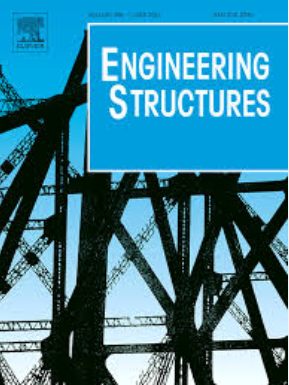Seismic reliability of low-prestressed self-centering braces considering steel dissipater fracture
IF 5.6
1区 工程技术
Q1 ENGINEERING, CIVIL
引用次数: 0
Abstract
Low-Prestressed Self-Centering (LPSC) braces are newly developed brace systems which limits both seismic peak and residual deformations, with a low requirement of prestressing forces. These systems utilize ratchet components to minimize the resistance from dissipaters to re-centering systems. Two types of LPSC braces, i.e., Symmetric Hysteresis LPSC (SH-LPSC) brace and Tension-Only LPSC (TO-LPSC) brace, have three common features of their steel dissipaters: 1) occupy a small portion of the entire brace; 2) slender; 3) made by carbon-steel. These characteristics denote a new challenge, that the seismic elongation demand (which cumulates in cyclic loadings) might exceed their limited capacity of steel dissipaters. To secure the use of LPSC braces, this study focuses on evaluating the seismic reliability of LPSC braces considering the fracture of steel dissipaters. First, the elongation capacity of carbon-steel dissipaters, which was adopted in previous studies, and stainless-steel dissipaters, which was proposed, were experimentally investigated. Then, numerical models for both LPSC systems were developed and used to calculate the elongation demand of LPSC systems under mainshocks and mainshock-aftershock sequences through nonlinear dynamic analyses. Based on the numerical results, a mathematic model was developed to predict the elongation demand of steel dissipater. Furthermore, the seismic reliabilities of the two LPSC systems with carbon- and stainless-steel dissipaters were investigated by comparing the elongation demand of steel dissipaters against their capacity in a probability manner. Results indicate that SH-LPSC systems have a higher reliability than TO-LPSC systems because it has lower probability of steel dissipaters fracture at certain drifts. When carbon-steel dissipaters were used, LPSC systems showed a high fracture likelihood, particularly under mainshock-aftershock sequences (15.29 % for SH-LPSC and 27.92 % for TO-LPSC systems). Conversely, stainless-steel dissipaters consistently exhibited near-zero fracture probabilities. Overall, adopting stainless-steel dissipaters substantially reduces brace failure risks, thereby enhancing the seismic reliability of LPSC braces.
求助全文
约1分钟内获得全文
求助全文
来源期刊

Engineering Structures
工程技术-工程:土木
CiteScore
10.20
自引率
14.50%
发文量
1385
审稿时长
67 days
期刊介绍:
Engineering Structures provides a forum for a broad blend of scientific and technical papers to reflect the evolving needs of the structural engineering and structural mechanics communities. Particularly welcome are contributions dealing with applications of structural engineering and mechanics principles in all areas of technology. The journal aspires to a broad and integrated coverage of the effects of dynamic loadings and of the modelling techniques whereby the structural response to these loadings may be computed.
The scope of Engineering Structures encompasses, but is not restricted to, the following areas: infrastructure engineering; earthquake engineering; structure-fluid-soil interaction; wind engineering; fire engineering; blast engineering; structural reliability/stability; life assessment/integrity; structural health monitoring; multi-hazard engineering; structural dynamics; optimization; expert systems; experimental modelling; performance-based design; multiscale analysis; value engineering.
Topics of interest include: tall buildings; innovative structures; environmentally responsive structures; bridges; stadiums; commercial and public buildings; transmission towers; television and telecommunication masts; foldable structures; cooling towers; plates and shells; suspension structures; protective structures; smart structures; nuclear reactors; dams; pressure vessels; pipelines; tunnels.
Engineering Structures also publishes review articles, short communications and discussions, book reviews, and a diary on international events related to any aspect of structural engineering.
 求助内容:
求助内容: 应助结果提醒方式:
应助结果提醒方式:


